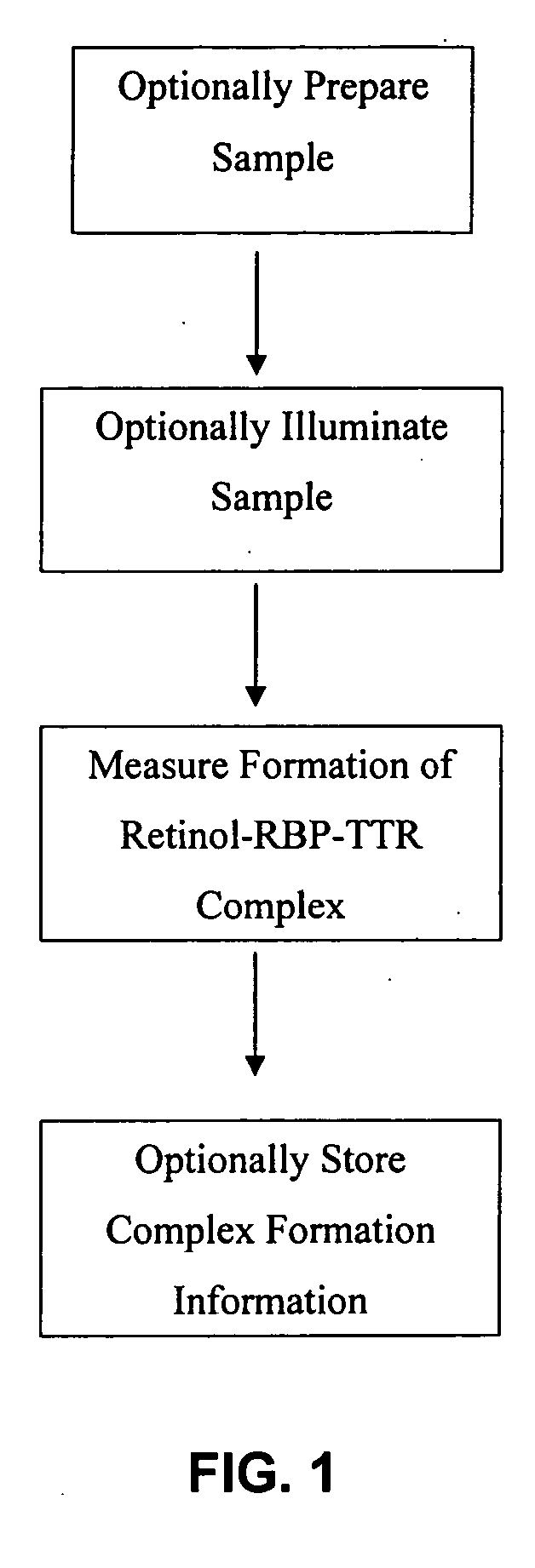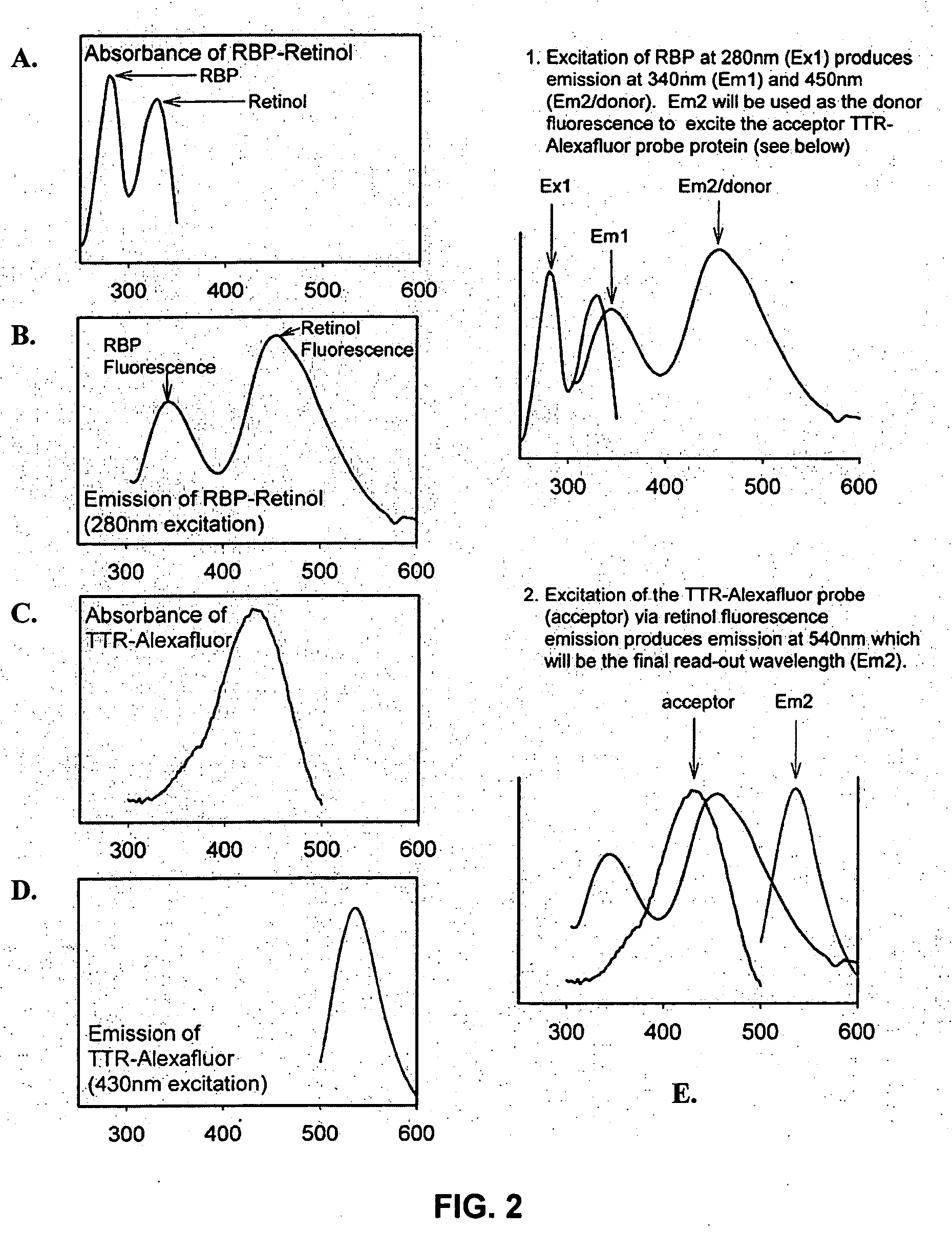Modulators of retinol-retinol binding protein (RBP)-transthyretin (TTR) complex formation
a technology of retinol and binding protein, which is applied in the field of modulators of retinol-retinol binding protein (rbp)transthyretin (ttr) complex formation, can solve the problems of severe damage to the central vision, no effective cure for macular degeneration, and gradual loss of vision, so as to reduce the serum retinol level, reduce the ocular level of retinol, and reduce the detected signal
- Summary
- Abstract
- Description
- Claims
- Application Information
AI Technical Summary
Benefits of technology
Problems solved by technology
Method used
Image
Examples
example 1
Labeling of TTR
[0163] TTR (Sigma Chemical Co.) was dissolved in phosphate buffered saline (PBS) buffer (pH 7.2), and the protein concentration adjusted to about 2-3 mg / ml. Prior to labeling, 10% (v / v) of 1M NaHCO3 (pH 8.3) was added to raise the sample pH.
[0164] A 4-times molar excess of ALEXA FLUOR® 430 (Molecular Probes) stock solution (in DMSO) was added to the protein solution. The mixture was incubated at room temperature on a Nutator in the dark. After 30 min, another aliquot of the fluorescence probe was added at approximately the same quantity as the first aliquot. The mixture was incubated for another 30 minutes.
[0165] ALEXA FLUOR® 430 labeled-TTR was separated from the free probe using Econo-Pac 10 DG desalting column (Bio-Rad). The protein fraction was concentrated and the residue amount of free probe further removed using Centricon YM-3 (Millipore) concentration devices.
[0166] The absorbance of the labeled protein solution at 280 and 434 nm was measured using a spect...
example 2
Fluorescent Measurement of TTR and RBP Binding
[0169] 3 ml of 1 μM TTR or Alexa Fluor 430-labeled TTR was prepared in PBS buffer and placed in a 3-ml fluorescent cuvette. The emission spectrum was measured between 290 nm to 650 nm with the excitation wavelength at 280 nm, and emission spectrum between 340 nm to 650 nm with the excitation wavelength at 330 nm, using a Jobin-Yvon Fluorolog 3 spectrofluorimeter. The band pass of the spectrofluorimeter was set at 1.5 nm.
[0170] Small aliquots of concentrated holo-RBP (retinol bound to RBP) stock solutions was then sequentially added to the TTR solution. The final concentrations of RBP were 0.33 μM, 0.67 μM, 1 μM, 1.33 μM, 1.67 μM and 2 μM, respectively. After each addition, the sample was mixed and incubated at room temperature for 20 min. The fluorescence spectra was measured as above. The contribution of RBP to the emission was subtracted from the measured spectra by using blanks of RBP at appropriate concentrations.
[0171] Two emissi...
example 3
Comparison of Aromatic Amino Acid Quenching
[0172] The currently used method for detection of RBP-TTR interaction relies on quenching of TTR protein (aromatic amino acid) fluorescence in the present of increasing concentrations of RBP. Analysis of crude sera is not permissible in this assay due to the presence of other interfering proteins in sera. Therefore, RBP must be purified from crude sera prior to analysis of TTR binding. This is a time consuming process which is not amenable to high-throughput screening. An example of data obtained using this technique is provided in FIG. 4A. In FIG. 4A, the fluorescent emission of the retinol-RBP-unlabeled TTR complex is measured with excitation at 280 nm. The different curves in the graph represent increasing concentration of RBP added to the sample mixture. At higher amounts of RBP, where increasing levels of RBP are complexed to unlabled TTR, the complexed RBP gradually quenches the aromatic amino acid fluorescent signal on TTR.
[0173] I...
PUM
| Property | Measurement | Unit |
|---|---|---|
| emission wavelength | aaaaa | aaaaa |
| emission wavelength | aaaaa | aaaaa |
| emission wavelength | aaaaa | aaaaa |
Abstract
Description
Claims
Application Information
 Login to View More
Login to View More - R&D
- Intellectual Property
- Life Sciences
- Materials
- Tech Scout
- Unparalleled Data Quality
- Higher Quality Content
- 60% Fewer Hallucinations
Browse by: Latest US Patents, China's latest patents, Technical Efficacy Thesaurus, Application Domain, Technology Topic, Popular Technical Reports.
© 2025 PatSnap. All rights reserved.Legal|Privacy policy|Modern Slavery Act Transparency Statement|Sitemap|About US| Contact US: help@patsnap.com



